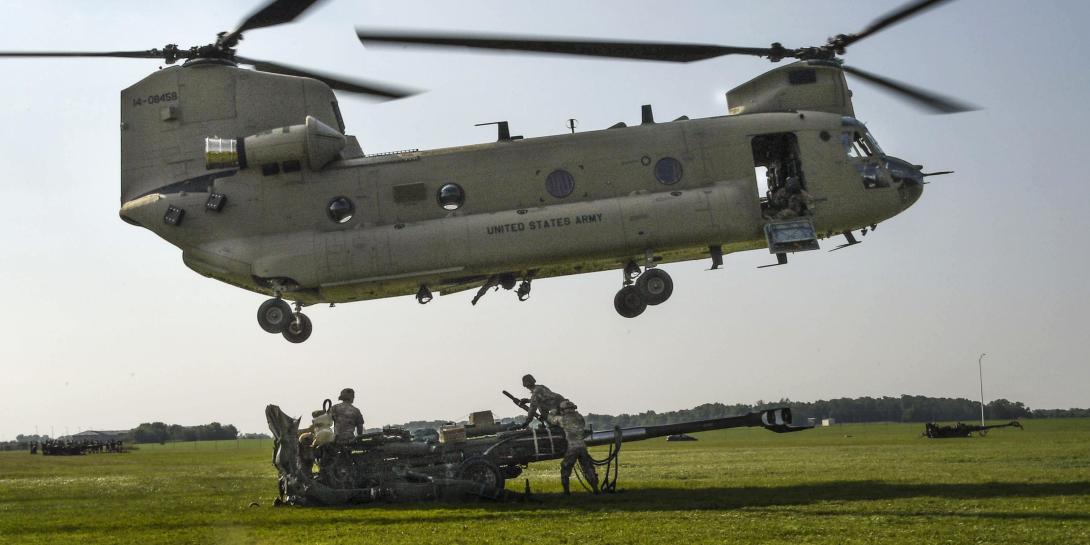6 Series: Tailored Command Posts and Data Endurance
This is the second in a series of online articles written by Army Signal Corps officers.
The 101st Airborne Division travels and moves light by helicopter and foot. Air assault troopers headed to the tactical edge—to the sound of the guns on the forward line of troops—carry only what they need for that fight, planning a resupply during consolidation of gains.
We use the technique of only carrying three days of supplies: three days of food, three days of ammunition, three days of water and so on. So why should we treat data and computer processing power—assets that Army senior leaders say will be as important as ammunition on the future battlefield—any differently?
To make our information environment as tactically expeditionary as our soldiers and helicopters, the division needed a big idea to drive change in our traditional techniques and procedures governing information exchange. The big idea was to use the division’s instantiation of DragonCloud, which securely stores and manages mission data off premise, and local edge servers to provide continuity of operations to all command posts during all phases of the operation, regardless of connection to the Department of Defense Information Network, or DODIN. A command post fighting off three days’ supply of data will be more agile, mobile and flexible than a command post that is encumbered with a need to run all its data stacks with as many robust connections to the DODIN as possible.
Experimenting with tailoring command posts is one part of the XVIII Airborne Corps’ Project Ridgway. Later this spring, as part of the Operation Lethal Eagle II training exercise, the 101st Airborne Division (Air Assault) will use emerging cloud capabilities to operate command posts in a much more mobile, agile and dispersed construct than if the command posts were dependent on constant connections to other deployed command posts’ networks.
Our aim is to rehearse and deepen our understanding of operating command posts in a disconnected state. When we disconnect, we will cache what we believe is a three-day supply of data, then we will “resupply” by synchronizing field connections to the cloud to pull down updated mission data, before we break links and move again.
For this exercise, our goal is to routinely and deliberately disconnect command posts from their external connections and use DragonCloud to provide continuity of operations to the remaining connected command posts. This approach will give our data endurance beyond the availability and performance of various command posts’ local area networks.
In the past, if the Task Force’s data was primarily stored on premise at a command post, the data would only be as available to other command posts as the primary command post’s network, potentially creating a single point of failure. The assumption that a matrix of command posts across a front can all rely on highly available networks to use each other’s data is network centric. For several reasons, the future needs to be data centric, not network centric.
Increasing resiliency
One reason that highly available network centric architectures should be suspect is that if a command post is transmitting in the electromagnetic spectrum or emitting power to connect to external networks, the enemy can often find our forces. Our command posts, with all our data hosted locally and connecting to other command posts via external networks, look like small cities.
Rather, imagine the headquarters as a submarine, where operating disconnected is like operating underwater. When it emerges “above the surface” it can connect to the cloud to transmit and receive current, relevant data, and then go “back under the surface” to hide so the enemy can’t detect it. All the data needed for the mission period is locally hosted on edge servers, and all the data needed for the next mission and the overall campaign is hosted in the cloud (and available to any command posts that have “resurfaced” to synch data). To build that capability, we need to experiment with pulling the plug, fighting disconnected and seeing what happens.
From a technical perspective, to achieve that goal, we have set up an impact level 6 (SECRET) instance of mission command information systems hosted in a secure tactical cloud environment, with servers at a separate site as disaster recovery. In that cloud, we have all of the data the division would typically have in a traditional command post that would take days to establish.
On the edge, we have high-powered servers that are running programs we need, with the amount of data that we think we need to run those programs. We’re going to see how feasible it is for us to operate without bringing more data to the fight. When it’s time to move, we will reconnect to the cloud, resupply our data and move out.
This is the kind of experimentation we have to do now to increase our resiliency, because the next fight isn’t going to allow us to just set up our very large satellite dishes in a single location for a 12-month period, then take them down and go home. While we know that our current mission command information systems are not built do this, forcing them to do this, and then reporting the outcomes to our teammates at Army Futures Command and the Program Executive Office for Command, Control, and Communications-Tactical (PEO C3T), should help the Army develop and integrate software that organically and by design supports this operating concept.
Cloud supports data centricity
Operation Lethal Eagle II is an opportunity to take the next step in a cloud experimentation effort that our division started last year, working closely with the XVIII Airborne Corps, the Army Enterprise Cloud Management Agency, PEO C3T, the Network Cross-Functional Team and Long Range Precision Fires Cross-Functional Team, and other stakeholders such as I Corps and the Multi-Domain Task Force.
Initially, we worked at the controlled unclassified information level to allow the soldiers and engineers to become familiar with the hybrid tactical cloud tools and environment. We then added notional mission data aligned to Army mission command systems, so once impact level 6 became available, we were postured to move rapidly into that environment.
Our initial goal was just to see what we could do with the technology. But it soon became clear that in the current and future operating environment the cloud will be critical to mission success.
In a modern conflict, we have to expect intermittent network connectivity and access. The cloud is a place to store data that can be available to our division elements, and other military and intelligence partners as required, even if some nodes are operating disconnected. There is a sense of urgency to use cloud as a continuity of operations capability, and our efforts are helping to drive that forward for the Army.
Additionally, as the Army adapts to the division as the primary unit of action, it will allow us to more centrally implement technologies like cloud, while allowing brigade network staffs to focus on Integrated Tactical Network capabilities that provide a deployable, mobile and adaptable combat fighting network for lower echelons.
Leveraging cloud capabilities is part of a larger Army transformation to become more data-centric, which the division also supports. In the past, we carried the network to the fight on our backs. We were focused on bringing all of our networking equipment, all of our servers, all of our stacks—everything we could ever need, which meant it was very heavy and slow to move.
With data centricity, we’re only bringing enough network to the fight to get and transmit the data we need. Instead of tailoring mission packages to broad information exchange requirements, data centricity allows us to focus at a more granular level on what the specific data is for that mission, and tailor the network to our actual processing requirements. That makes us not only lighter on the edge, but also more deliberate, tactical and survivable.
Conclusion
Adding cloud and data experimentation into our division training cycle is a real-time learning experience. We don’t know what we can accomplish if we don’t try, and the best time to try is through training exercises where we control the risk. It’s a great opportunity to see what we can do, and push our division, the corps and hopefully the Army forward by experimenting with other modes of operations, not just the static network environments of the past. Already, it is clear that data needs to be considered early and often during mission planning and execution, just like beans and bullets. We will start with a three-day supply.
Lt. Col. Randall “Randy” Linnemann, USA, is currently the G6 for 101st Airborne Division (Air Assault). He serves as the principal advisor to the commanding general for all matters regarding communications and information technology and is responsible for all networks and information technology used by forces assigned to the division. Prior to serving as the G-6, he served as the director of the CJ6 for the NATO Special Operations Component Command-Afghanistan/Special Operations Joint Task Force-Afghanistan and was responsible for all special operations communications networks in Afghanistan. He has also previously served in Joint Special Operations Command’s Joint Communications Unit and the Army’s elite 75th Ranger Regiment.





Comments